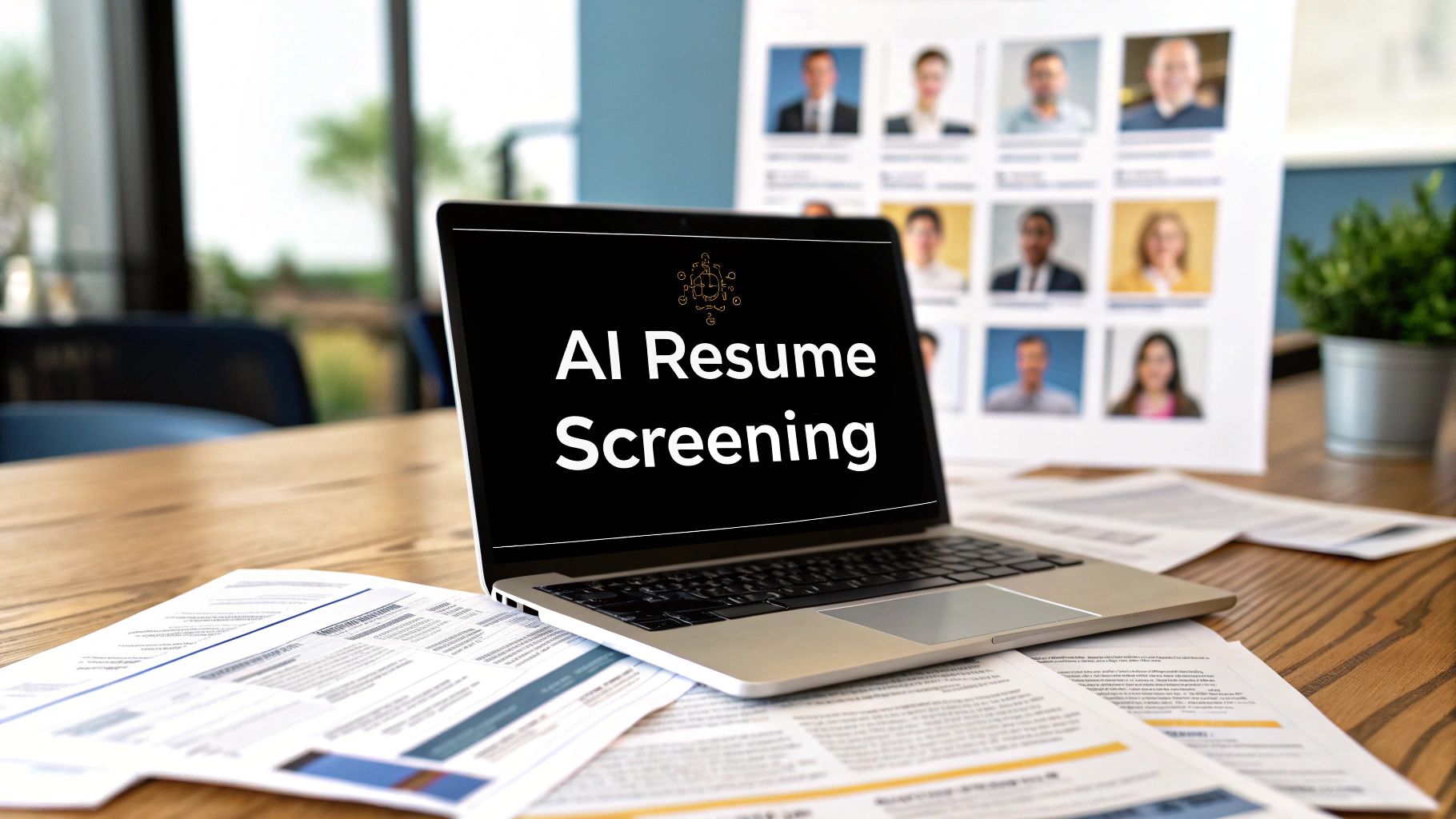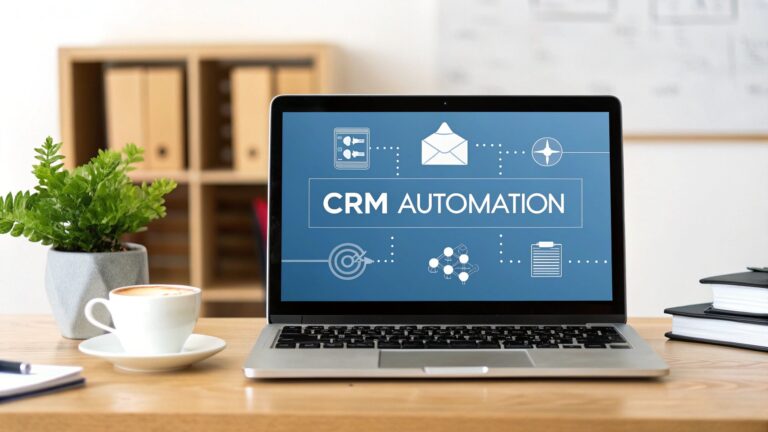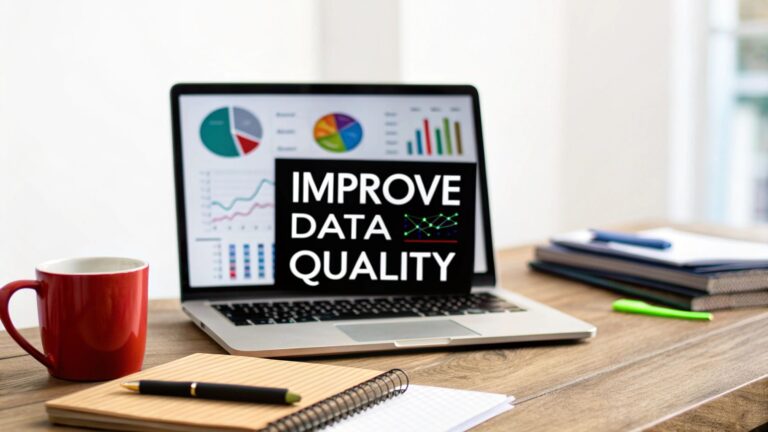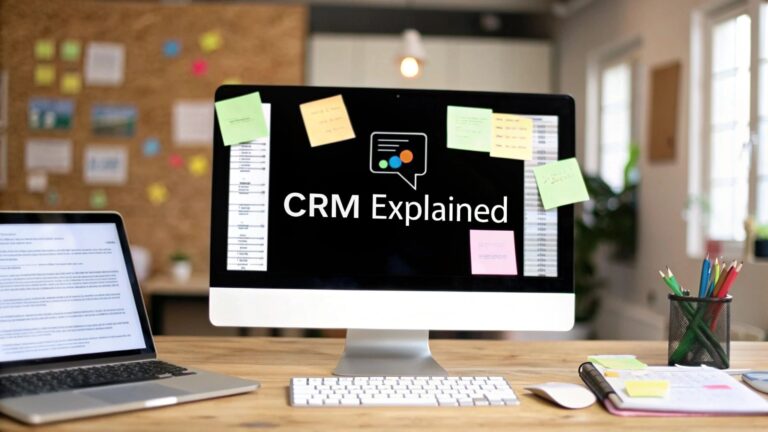A Guide to AI Resume Screening Tools
AI resume screening tools are no longer just a futuristic concept; they are intelligent platforms that automate the very first, and often most time-consuming, part of hiring. They use artificial intelligence to analyze, sort, and rank candidates based on their actual qualifications. This goes way beyond simple keyword matching, giving HR teams a massive head start.
For B2B and SaaS leaders, this means finding top talent faster and with a lot less friction.
The Reality of Modern Hiring with AI
Let’s cut through the buzzwords and talk about how AI resume screening tools are changing the game for recruitment teams on the ground. For anyone in HR or operations, this technology signals a fundamental shift. We're moving away from the soul-crushing task of manually sifting through hundreds—sometimes thousands—of applications and toward a much smarter, data-backed approach.
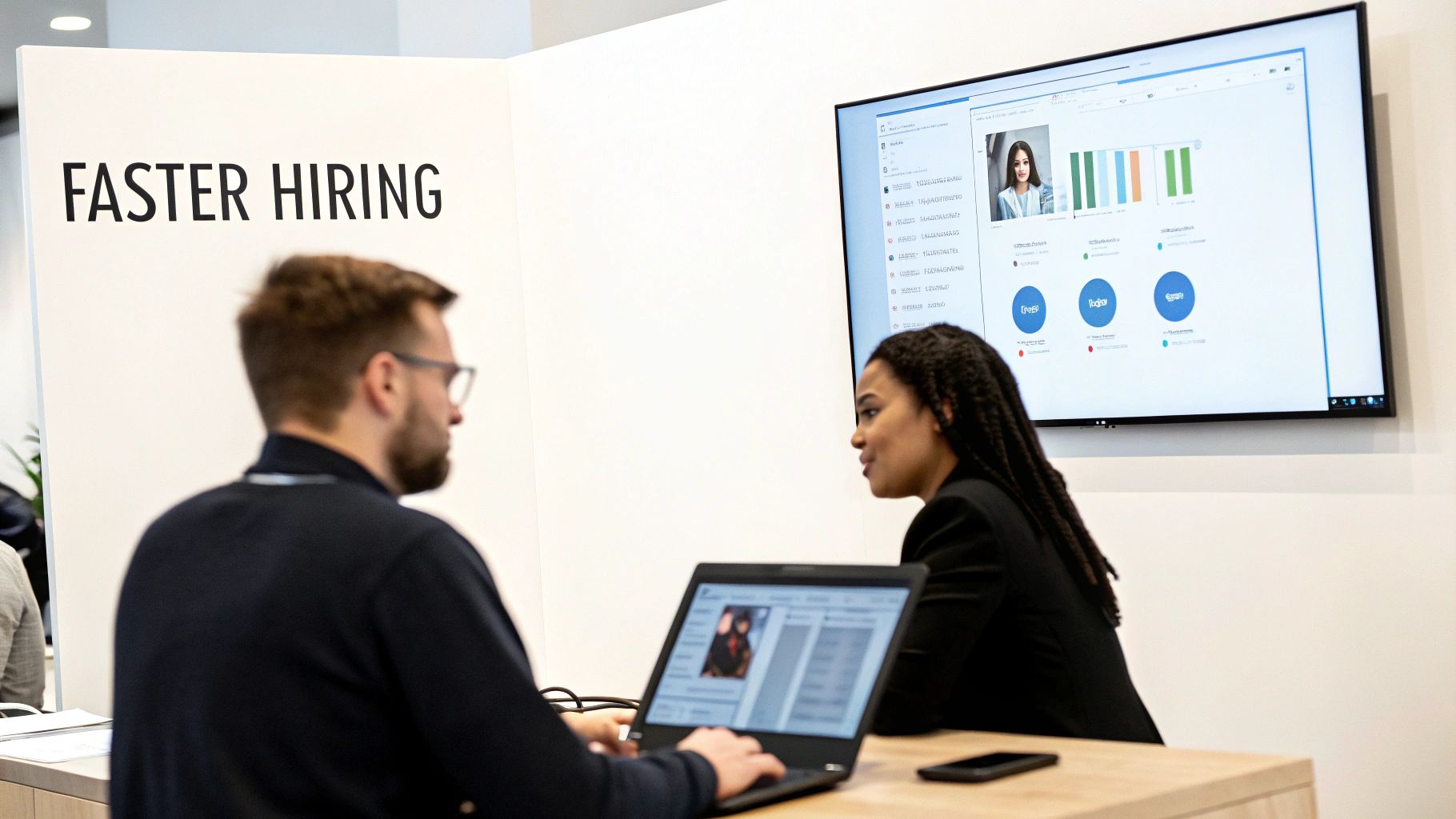
Think about a high-growth tech company that slashes its time-to-hire in half. Or a large retailer that handles a massive influx of seasonal applicants without burning out its entire HR department. These aren't just hypotheticals. These are real-world results happening today because companies are automating the initial screen to pinpoint the best candidates with incredible speed and accuracy.
Why This Shift Is Happening Now
The move toward AI in hiring isn't just a trend; it's an acceleration. Projections show that by 2025, a staggering 67% of organizations will be using AI in their recruitment efforts. That’s a huge leap from just 24% back in 2022.
The two most common uses are where the technology shines brightest: resume parsing and skill matching. We're seeing 94% accuracy with resume parsing and 89% accuracy in identifying the right candidates with skill matching. Even more impressive, these tools are slashing the time spent on screening by up to 82% and 61%, respectively.
This isn't happening just because the technology is available. It's a direct response to a hyper-competitive talent market where speed and precision are everything. The core benefits are simply too compelling to overlook:
- Unmatched Efficiency: An AI tool can tear through thousands of resumes in the time it takes a recruiter to get through a small stack, delivering a qualified shortlist almost instantly.
- Significant Cost Savings: When you reduce manual hours and shorten the hiring cycle, you directly lower operational costs and lessen the financial blow of having critical roles sit empty.
- Improved Talent Matching: Sophisticated algorithms look beyond keywords to analyze skills, experience, and even potential. This leads to better-quality hires who are far more likely to thrive and stick around.
The point of AI screening isn't to replace recruiters. It’s to free them from the high-volume, repetitive work that gets in the way of what they do best: connecting with great candidates and building real relationships.
Impact of AI Screening on Key Recruitment Metrics
To put it in concrete terms, adopting an AI-powered screening tool has a direct and measurable effect on the most important recruitment KPIs. Here’s a look at the kind of improvements you can realistically expect.
| Recruitment Area | Metric Improvement (Average) | Primary Benefit |
|---|---|---|
| Time-to-Fill | 35% reduction | Faster hiring cycles, reduced productivity loss from vacant roles. |
| Cost-per-Hire | 40% reduction | Lower administrative overhead and less time spent by recruiters on sourcing. |
| Candidate Quality | 45% increase | Better alignment of candidate skills and experience with job requirements. |
| Recruiter Productivity | 60% increase | More time spent on strategic tasks like interviewing and candidate engagement. |
| Diversity & Inclusion | 25% increase | Reduced unconscious bias leads to a more diverse applicant pool. |
Ultimately, these tools provide a clear competitive advantage. They don't just make hiring easier; they make it smarter and more effective across the board.
For a broader look at the benefits and strategic implications, this guide on the power of recruiting AI is a fantastic resource that adds valuable context. In today's talent landscape, these tools are quickly becoming table stakes.
Choosing the Right AI Screening Vendor
Picking an AI partner is a major investment, and it’s about a lot more than just buying a piece of software. The market for AI resume screening tools is packed with vendors all promising the world. To cut through the noise, you need a solid framework to look past the sales pitch and figure out what actually matters for your company’s real-world hiring problems.
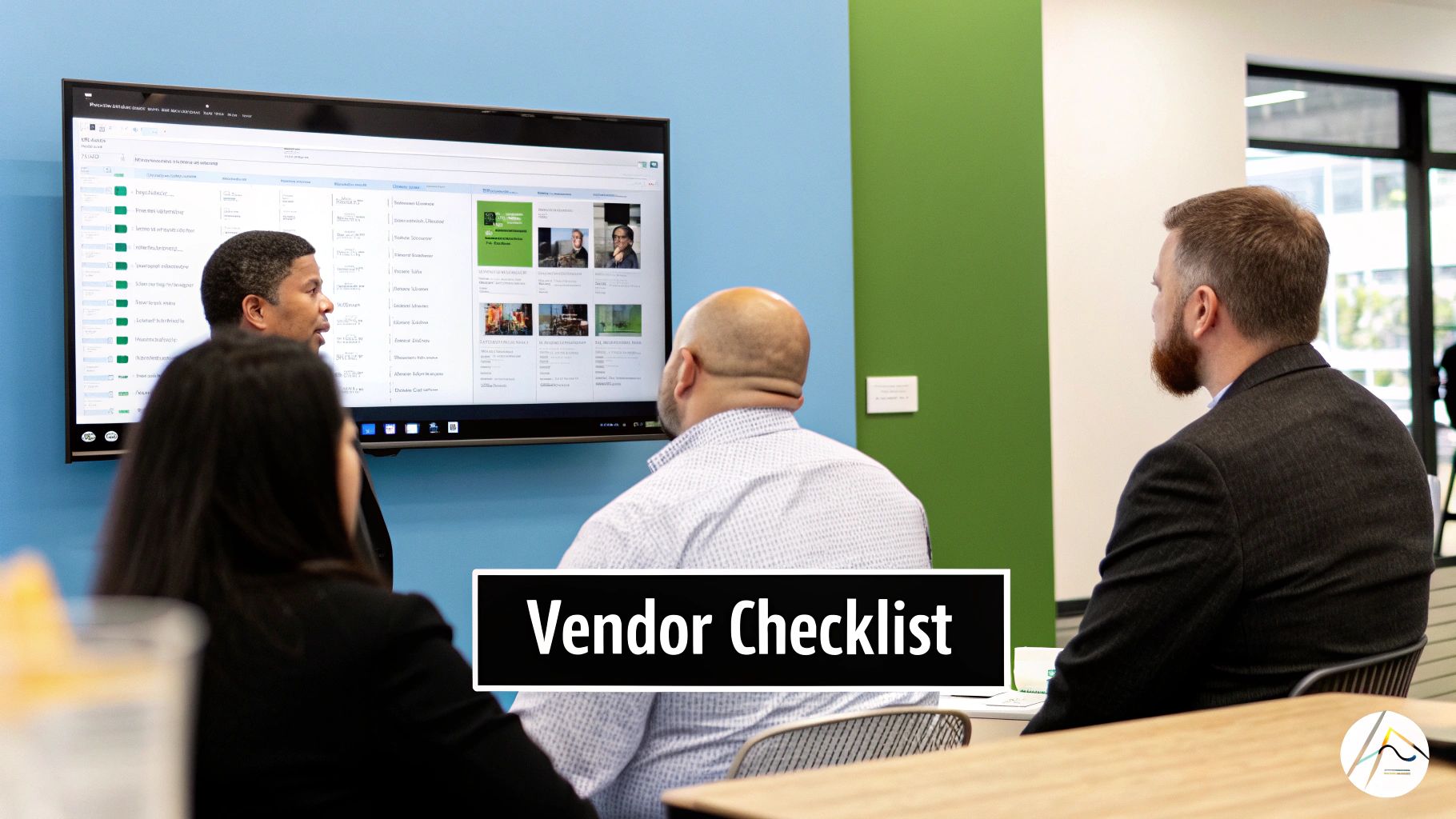
This means you’ve got to shift your focus from flashy, nice-to-have features to the core functionality that will make a difference. A successful partnership really comes down to whether the tool can understand skills in context, plug into your existing workflow without a major headache, and adapt to your specific needs. You're looking for a vendor that aligns with your long-term talent strategy, not just one that can solve a short-term administrative headache.
Look Beyond Simple Keyword Matching
Let's be honest, the most basic AI screeners are just fancy keyword finders. The real value comes from platforms that use Natural Language Processing (NLP) to grasp the meaning behind the words on a resume. That contextual understanding is what separates a top-tier tool from a simple parser.
When you’re sitting through a demo, don't be afraid to ask some tough questions about their skill ontology—that’s the framework they use to classify and connect different skills. For instance, does their system know that "agile project management" is a dead ringer for a "Scrum Master" role, even if that exact phrase isn't in your job description? A truly powerful tool will get those nuances right.
Another thing to dig into is the granularity of their matching scores. A simple "95% match" score is pretty much useless on its own.
A good vendor should be able to break down exactly why a candidate scored the way they did. The system needs to highlight which specific skills, experiences, and qualifications fed into that ranking, giving your recruiters the transparency they need to actually trust the recommendations.
Develop a Vendor Evaluation Scorecard
To keep your evaluation process consistent and objective, build a scorecard. This little trick ensures you're comparing every vendor on the same level playing field, so you don't get sidetracked by a slick presentation. Your scorecard should be built around your top priorities, but here are a few non-negotiable categories to get you started:
- Skill Analysis Depth: How well does it actually interpret skills and experience? Can it spot transferable skills, or is it just looking for exact keyword matches?
- Customization and Learning: Can you train the platform on your own data? A huge plus is the ability to upload profiles of your top performers to teach the AI what "good" looks like at your company.
- Integration Capabilities: How smoothly does it integrate with your current Applicant Tracking System (ATS)? Insist on a clear answer about the typical implementation timeline.
- Bias Mitigation Features: Get specific. What concrete measures does the vendor take to find and reduce algorithmic bias? Ask them about their training data and their approach to "explainable AI."
- User Experience (UX): Is the interface actually easy for recruiters and hiring managers to use? A clunky system will kill adoption, no matter how powerful the AI is under the hood.
If you need more ideas on what to look for, checking out a list of the best AI tools for recruitment can give you a good sense of market standards and what's possible.
Prioritize Customization and Real-World Testing
A one-size-fits-all approach is a recipe for disaster in recruiting. Your company has its own unique culture and very specific needs for every role you fill. The best AI tools get this and allow for deep customization. During any trial period, you have to insist on running a pilot program using one of your actual, hard-to-fill roles.
Hand the vendor a set of 10-15 resumes for that role—make sure to include a mix of strong, so-so, and clearly unqualified candidates. This kind of real-world test is worth a dozen canned demos. It’s the only way to see how the tool really performs with your data and your job requirements.
Finally, take a hard look at their support and partnership model. Are they genuinely invested in your success, or are they just racing to get the contract signed? The right vendor acts more like a strategic partner, offering guidance and helping you refine your process to get the most out of their tech. Go with the partner who is committed to helping you build a smarter, more effective hiring machine for the long haul.
How to Mitigate Bias in AI Recruitment
Let's be blunt: getting fairness right isn't just a compliance task—it's the single most important part of bringing AI resume screening into your company. If you aren't careful, these tools can accidentally pick up and even magnify the very human biases you're trying to get rid of. The whole point is to find an AI partner that genuinely broadens your talent pool, not one that quietly narrows it.
This means you have to get proactive. You can't just take a vendor's "bias-free" marketing claims at face value. It's on you to get under the hood, ask tough questions about their data, and demand total transparency.
Performing a Vendor Bias Audit
Before you even think about signing a contract, you need to conduct a serious bias audit. This isn't a quick once-over; it's a deep dive into how the vendor built their technology and what ethical lines they've drawn in the sand. At the end of the day, an AI model is only as good as the data it was trained on. Garbage in, garbage out.
Start by hitting vendors with specific, pointed questions about their training data:
- Data Sources: Where, exactly, did you source the data to train your model? Did it come from a few specific industries or regions that might skew the results?
- Demographic Representation: What steps have you taken to ensure your training datasets reflect a diverse population across gender, ethnicity, age, and other protected groups? Can you show me the numbers?
- Data Freshness: How often do you update your training data? An AI trained on hiring patterns from five years ago is going to be wildly out of date.
A vendor who has done their homework will have confident, direct answers. If you get vague replies or they seem hesitant to talk about their data, that's a massive red flag. This initial check is your first and best defense against baking bias into your hiring process.
Championing Explainable AI
One of the biggest traps with AI is the "black box" problem—when a tool gives you a recommendation but can't tell you why. This is where Explainable AI (XAI) is absolutely critical. XAI isn't just a buzzword; it's a set of practices that force an AI to show its work in a way a human can actually understand.
For instance, a poorly built algorithm might consistently rank candidates from non-traditional backgrounds lower. Without XAI, you'd have no idea why. With it, the system could highlight that it's penalizing applicants for not having a degree from a specific list of "target" schools—a clear source of bias you can immediately address.
Insist on a tool that provides a clear rationale for every single candidate score. Your recruiters have to be able to see why someone was ranked high or filtered out. This keeps humans in the driver's seat, allowing them to sanity-check the AI’s logic and make the final call.
This level of transparency isn't a nice-to-have; it's essential for building a fair and defensible process. The broader conversation around how automation in talent acquisition to mitigate bias is changing the game is worth exploring further, as it touches on efficiency and fairness in equal measure.
Building an Equitable Screening Process
Even after you've picked the right tool, your job isn't over. The human-in-the-loop is still the most important part of the equation. We’ve seen studies showing that AI-generated scores can differ wildly from what a human recruiter would decide, often because the training data wasn't representative in the first place. You have to actively build guardrails around the tech.
Here are a few practical steps to keep your process equitable:
- Anonymize Profiles: Flip the switch on any feature that can hide demographic details like names, photos, and even graduation years during the first pass. This forces everyone—and the AI—to focus only on skills, experience, and qualifications.
- Regularly Audit Outcomes: Keep a close eye on your hiring data. After implementing the tool, are you seeing a sudden drop in applicants or hires from certain groups? Your own data is the best early-warning system you have.
- Train Your Team: Make sure your recruiters and hiring managers understand what the AI is good at and, more importantly, what it's not. It’s a powerful assistant, but it is not the decision-maker.
By combining a tough vendor audit with a commitment to explainable AI and constant human oversight, you can turn your screening tool from a potential risk into a genuine asset. It’s how you build a more diverse, more talented team, and it’s a cornerstone of the talent acquisition best practices that define modern HR.
Getting Your New AI Tool Up and Running: An Implementation Playbook
Bringing a new AI resume screening tool into your workflow isn't like flipping a switch. It's a deliberate process. If you want a smooth rollout that your team actually embraces, you need a solid game plan that moves from a small-scale test to a full, seamless integration.
The smartest way to begin is with a focused pilot program. Forget about a risky, company-wide launch. Instead, pick one department to be your test case. Your engineering or sales teams are often great candidates, since they usually have high hiring volumes or notoriously tricky roles to fill. This gives you a controlled environment to work out the kinks, see what works, and get real feedback before you go big.
The journey looks something like this:
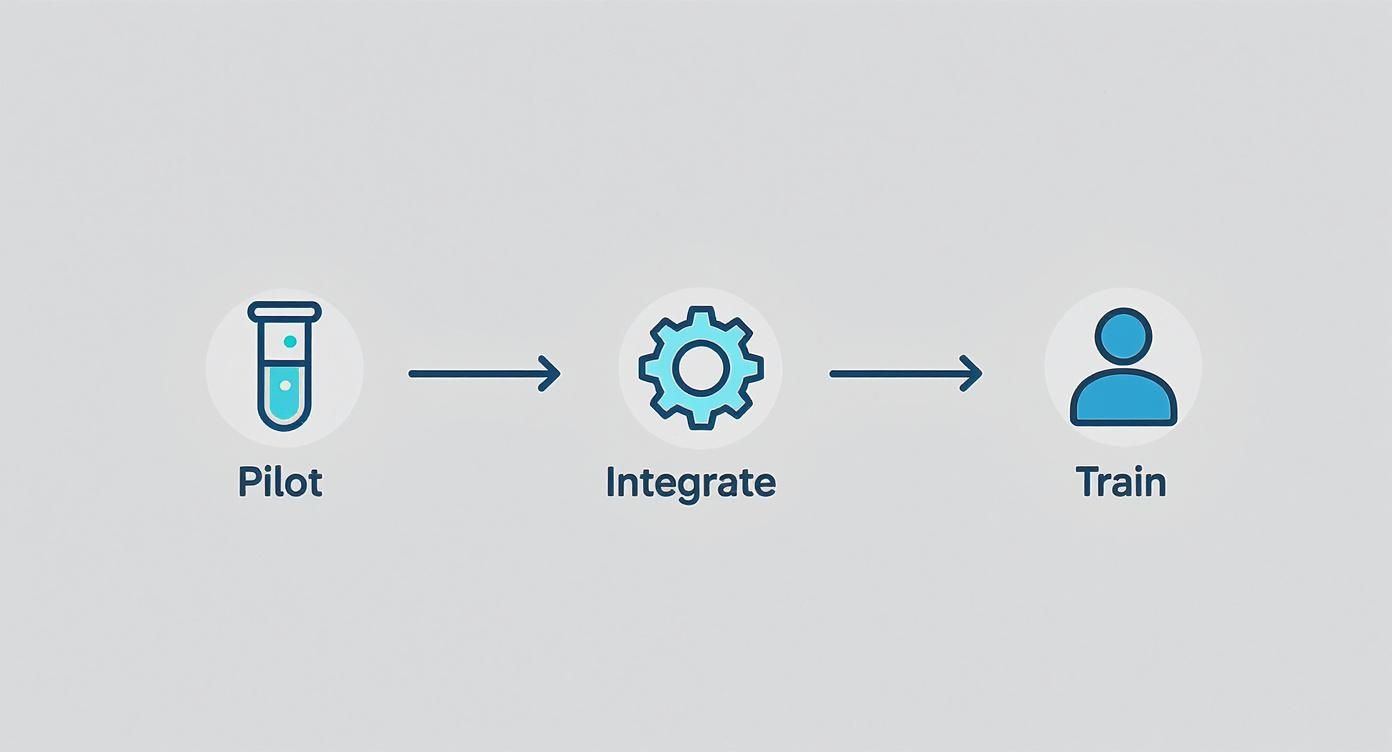
As you can see, it’s a logical flow. You start with a pilot to learn, then lock in the technical integration, and finally, focus on training your people. Each step builds on the last, ensuring you don’t get ahead of yourself.
Nailing the ATS Integration
Your Applicant Tracking System (ATS) is the heart of your recruiting operation. Any new tool has to play nicely with it. If it doesn't, you'll end up with data stranded in different systems and frustrated recruiters trying to manage clunky workarounds. A clean, two-way data flow is absolutely essential.
Before you even sign a contract, get confirmation from the vendor that they offer a native, API-based integration with your specific ATS. When it’s time to connect the two, the devil is in the details. Focus on mapping the data fields perfectly. You want the AI tool's candidate scores, tags, and shortlist status to show up automatically in the right fields within your ATS candidate profiles.
A botched integration can be a nightmare, causing duplicate candidate records or, even worse, losing applications entirely. It’s worth brushing up on the core applicant tracking system features to make sure your central hub is ready for this kind of upgrade.
A truly great integration does more than just sync data—it makes life easier for your recruiters. They shouldn't have to bounce between two systems. The goal is a single, unified screen where the AI’s insights appear right where they already work.
Winning Over Your Team With Smart Change Management
A powerful tool is useless if nobody uses it. This is where a good change management plan comes in. Your goal is to get recruiters and hiring managers excited, not skeptical. The key is to position the AI tool as a powerful assistant—something that handles the grunt work so they can focus on what matters.
Make your training sessions practical and specific to each role. Show recruiters how the tool automates the tedious first-pass screening, giving them more time to actually talk to great candidates. For hiring managers, highlight how it delivers a stronger, more relevant shortlist in a fraction of the time.
To make sure everyone is on the same page, document a few simple Standard Operating Procedures (SOPs). This takes the guesswork out of it and shows your team exactly how to weave the tool into their daily habits.
Here are a couple of SOPs you could create:
-
SOP 1: The AI-Assisted Shortlist Review
- The recruiter reviews the top 15-20 candidates ranked by the AI for the new opening.
- They spot-check the AI's work by manually reviewing the resumes of the top 5 candidates.
- Confirmed fits are moved to the "Hiring Manager Review" stage in the ATS.
- To make the AI smarter, the recruiter provides quick feedback on at least two candidates the AI got wrong.
-
SOP 2: Calibrating the AI for a New Role
- Before the job goes live, upload 3-5 resumes from current high-performers in that same role.
- Use these "gold standard" profiles to teach the AI what "great" really looks like for this position.
- Run the AI on the first batch of applicants and review the top results with the hiring manager to make sure you're on the right track.
These straightforward workflows eliminate confusion and give your team the confidence to use the new tool effectively. By starting small with a pilot, getting the tech right, and guiding your people through the change, you’re not just installing software—you’re building a better, smarter hiring process.
Measuring the ROI of Your AI Screening Tool
So, you’ve invested in an AI resume screening tool. How do you prove it’s actually worth the money? It's not enough to just say things "feel faster." To justify the ongoing cost and secure future budget, you have to connect the dots between the technology and real business outcomes.
This means you need to think beyond simple efficiency metrics and start tracking the strategic impact the tool has on your entire talent pipeline—and ultimately, the health of the company.
The first step is a simple one, but it's the one most people skip: establish your baseline. Before you roll out the tool, you need to know where you stand today. What’s your current time-to-fill for key roles? What does your candidate pipeline diversity actually look like? How many hours are your recruiters burning on manual screening each week?
This data is your anchor. Without it, you’re just guessing at the tool's impact.
Moving Beyond Time-to-Fill
Look, a faster time-to-fill is great, and it's an easy win to report. But frankly, it only tells part of the story. The real ROI—the kind that gets the C-suite’s attention—comes from focusing on more strategic KPIs. These are the numbers that show how the tool isn't just making you faster, but is fundamentally improving the quality of your workforce.
Let's dig into the metrics that truly matter:
- Quality of Hire: This is the big one. You need to track the performance of candidates sourced by the AI throughout their first year. Are they hitting their goals? Are they getting strong performance reviews? Finding a clear link between AI-sourced candidates and your top performers is the ultimate proof of value.
- Candidate Pipeline Diversity: Don't just talk about DEI—measure it. Use the tool’s analytics to see how the demographic makeup of your qualified applicant pool changes over time. A successful implementation should lead to a clear, measurable bump in candidates from underrepresented backgrounds getting to the interview stage.
- Recruiter Sanity and Productivity: Your team is your internal customer. Send out a quick survey. Are they spending less time on tedious screening and more time actually talking to great candidates? You can also track the number of requisitions each recruiter can realistically handle now compared to before.
An AI screening tool isn’t just an operational expense; it's a strategic investment in your company’s most valuable asset—its people. The right KPIs will prove that you're not just saving time, but actively building a stronger, more diverse, and higher-performing team.
Presenting a Compelling Case to Leadership
Data is useless if you can't tell a story with it. When you’re giving a quarterly update to your leadership team, frame the results in the context of their biggest priorities. Don't just dump a spreadsheet on them; show them the direct impact on the business.
For example, instead of saying, "Our time-to-fill decreased by 15%," try this:
"By implementing our new AI screening tool, we cut our time-to-fill for senior engineering roles by 15%. That meant getting critical products to market an entire cycle sooner, which our product team estimates captured an additional $250,000 in revenue. On top of that, 60% of the engineers we hired through the AI platform exceeded expectations in their six-month reviews, which is a huge win for our talent quality."
See the difference? This approach ties the tool's performance directly to revenue, product velocity, and talent quality—metrics that every executive cares about.
To help you get started, here’s a simple framework for tracking and presenting these kinds of results.
KPI Template for AI Screening Tool Performance
This template provides a straightforward way to measure the impact of your AI screening tool across different parts of the business. It’s designed to help you track everything from talent quality to hard cost savings, making it easier to build a business case for leadership.
| KPI Category | Specific Metric | Measurement Method | Success Target |
|---|---|---|---|
| Talent Quality | First-Year Performance | Track performance review scores of AI-sourced hires vs. all hires. | 10% higher average performance score for AI-sourced hires. |
| Efficiency | Recruiter Hours Saved | (Old screening time – new screening time) x number of roles. | Save 20+ hours per recruiter per month. |
| Diversity | Pipeline Demographics | Analyze diversity data at the interview shortlist stage, pre- and post-AI. | Increase URG representation in interview shortlists by 15%. |
| Cost Savings | Reduced Agency Fees | Calculate the reduction in reliance on external recruiting agencies. | Decrease annual agency spend by 25% for roles using the tool. |
By systematically tracking these kinds of KPIs and framing your results around business goals, you’ll build an undeniable case for the value of your AI screening tool. This data-driven approach not only justifies the initial investment but also helps secure ongoing support and resources for your entire talent acquisition strategy.
Common Questions About AI Resume Screening
When you're looking at bringing in a new piece of tech like an AI resume screener, it's smart to have questions. In fact, you should be a little skeptical. Leaders I talk to always want to know how these platforms really perform in the messy real world, from handling weird career paths to the fear of making their own recruitment team obsolete.
Let's dig into some of the most common questions I hear. These aren't just technical details; they get to the core of how you build a great team. Getting clear answers here is non-negotiable before you sign any contracts.
How Do AI Tools Handle Non-Traditional Resumes or Career Gaps?
This is a great question because it cuts right to the chase: is the AI actually smart? The good news is that modern AI screeners have come a long way. They're designed to look past a perfect, linear career history. Using sophisticated Natural Language Processing (NLP), they don't just keyword-match; they analyze a candidate's skills and experiences in context.
This means they can identify transferable skills from what might seem like a totally unrelated field. For instance, a well-trained tool can see how a former teacher's "classroom management" and "curriculum development" are a fantastic match for your corporate "project management" and "training" needs. You can also typically configure them to downplay career gaps, focusing instead on the candidate's total qualifications.
My advice: When you’re talking to vendors, get specific. Ask them point-blank how their model handles creative portfolios, a history of freelance gigs, or resumes from people returning to the workforce. The best platforms will let you customize the weighting to make sure you don't screen out amazing people with unconventional backgrounds.
Will AI Replace My Recruitment Team?
The short answer? Absolutely not. The real goal here is to augment your team, not replace it. Think of these tools as a way to automate the most soul-crushing part of the job: sifting through hundreds of unqualified resumes.
Freeing your recruiters from that initial manual slog lets them focus on the high-impact work that only a person can do.
With AI handling the first pass, your team finally has the bandwidth to:
- Build genuine relationships with top candidates.
- Conduct deep, insightful interviews that go beyond the resume.
- Proactively build talent pipelines for future openings.
- Serve as true strategic advisors to hiring managers.
Suddenly, your recruiter's role shifts from an administrative gatekeeper to a strategic business partner. That's a huge win for their job satisfaction and your hiring outcomes. The human touch is still everything when it comes to assessing culture fit, building rapport, and ultimately, closing the deal.
What Is the Typical Cost of AI Resume Screening Tools?
Pricing for these tools is all over the map, but most vendors stick to a few common models. Getting a handle on them is the first step to building a budget and a business case that holds up.
Here’s what you'll typically see:
- Pay-per-job-post: You pay for each role you use the tool for. This is a solid option if your hiring is unpredictable or happens in bursts.
- Subscription (SaaS): A flat monthly or annual fee. This is usually tiered based on company size, the number of recruiter seats, or your average hiring volume.
- Volume-based: The cost is tied directly to how many resumes you screen. This makes sense for businesses that are always hiring in high volumes.
When you're crunching the numbers, don't forget to factor in potential one-time costs for implementation, integration with your ATS, and team training. To make your ROI case, think beyond just the license fee. Project the hours your team will save, the money you'll no longer spend on external agencies, and the massive financial upside of hiring better people who stick around longer. Just reducing bad hires by a few percentage points can save you tens of thousands of dollars a year.
At MakeAutomation, we live and breathe this stuff. We help B2B and SaaS companies integrate AI-powered solutions to streamline their entire operation, including recruitment. We're here to help you find and implement the right tools to ditch the manual work and get back to growing your business.
Discover how MakeAutomation can optimize your hiring process

